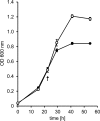Sulfolobus acidocaldarius Transports Pentoses via a Carbohydrate Uptake Transporter 2 (CUT2)-Type ABC Transporter and Metabolizes Them through the Aldolase-Independent Weimberg Pathway
- PMID: 29150511
- PMCID: PMC5772230
- DOI: 10.1128/AEM.01273-17
Sulfolobus acidocaldarius Transports Pentoses via a Carbohydrate Uptake Transporter 2 (CUT2)-Type ABC Transporter and Metabolizes Them through the Aldolase-Independent Weimberg Pathway
Abstract
Sulfolobus spp. possess a great metabolic versatility and grow heterotrophically on various carbon sources, such as different sugars and peptides. Known sugar transporters in Archaea predominantly belong to ABC transport systems. Although several ABC transporters for sugar uptake have been characterized in the crenarchaeon Sulfolobus solfataricus, only one homologue of these transporters, the maltose/maltooligomer transporter, could be identified in the closely related Sulfolobus acidocaldarius Comparison of the transcriptome of S. acidocaldarius MW001 grown on peptides alone and peptides in the presence of d-xylose allowed for the identification of the ABC transporter for d-xylose and l-arabinose transport and the gaining of deeper insights into pentose catabolism under the respective growth conditions. The d-xylose/l-arabinose substrate binding protein (SBP) (Saci_2122) of the ABC transporter is unique in Archaea and shares more similarity to bacterial SBPs of the carbohydrate uptake transporter-2 (CUT2) family than to any characterized archaeal one. The identified pentose transporter is the first CUT2 family ABC transporter analyzed in the domain of Archaea Single-gene deletion mutants of the ABC transporter subunits exemplified the importance of the transport system for d-xylose and l-arabinose uptake. Next to the transporter operon, enzymes of the aldolase-independent pentose catabolism branch were found to be upregulated in N-Z-Amine and d-xylose medium. The α-ketoglutarate semialdehyde dehydrogenase (KGSADH; Saci_1938) seemed not to be essential for growth on pentoses. However, the deletion mutant of the 2-keto-3-deoxyarabinoate/xylonate dehydratase (KDXD [also known as KDAD]; Saci_1939) was no longer able to catabolize d-xylose or l-arabinose, suggesting the absence of the aldolase-dependent branch in S. acidocaldariusIMPORTANCE Thermoacidophilic microorganisms are emerging model organisms for biotechnological applications, as their optimal growth conditions resemble conditions used in certain biotechnologies such as industrial plant waste degradation. Because of its high genome stability, Sulfolobus acidocaldarius is especially suited as a platform organism for such applications. For use in (ligno)cellulose degradation, it was important to understand pentose uptake and metabolism in S. acidocaldarius This study revealed that only the aldolase-independent Weimberg pathway is required for growth of S. acidocaldarius MW001 on d-xylose and l-arabinose. Moreover, S. acidocaldarius employs a CUT2 ABC transporter for pentose uptake, which is more similar to bacterial than to archaeal ABC transporters. The identification of pentose-inducible promoters will expedite the metabolic engineering of S. acidocaldarius for its development into a platform organism for (ligno)cellulose degradation.
Keywords: ABC transporters; Sulfolobus carbon metabolism; archaea; pentose metabolism; promoters; sugar transport.
Copyright © 2018 American Society for Microbiology.
Figures









Similar articles
-
Identification of XylR, the Activator of Arabinose/Xylose Inducible Regulon in Sulfolobus acidocaldarius and Its Application for Homologous Protein Expression.Front Microbiol. 2020 May 26;11:1066. doi: 10.3389/fmicb.2020.01066. eCollection 2020. Front Microbiol. 2020. PMID: 32528450 Free PMC article.
-
Uptake of D-xylose and L-arabinose in Haloferax volcanii involves an ABC transporter of the CUT1 subfamily.FEMS Microbiol Lett. 2019 Apr 1;366(8):fnz089. doi: 10.1093/femsle/fnz089. FEMS Microbiol Lett. 2019. PMID: 31089701
-
Metabolism of pentose sugars in the hyperthermophilic archaea Sulfolobus solfataricus and Sulfolobus acidocaldarius.J Biol Chem. 2010 Oct 29;285(44):33701-9. doi: 10.1074/jbc.M110.146332. Epub 2010 Aug 24. J Biol Chem. 2010. PMID: 20736170 Free PMC article.
-
Engineering of Pentose Transport in Saccharomyces cerevisiae for Biotechnological Applications.Front Bioeng Biotechnol. 2020 Jan 29;7:464. doi: 10.3389/fbioe.2019.00464. eCollection 2019. Front Bioeng Biotechnol. 2020. PMID: 32064252 Free PMC article. Review.
-
Pentose metabolism and conversion to biofuels and high-value chemicals in yeasts.FEMS Microbiol Rev. 2021 Aug 17;45(4):fuaa069. doi: 10.1093/femsre/fuaa069. FEMS Microbiol Rev. 2021. PMID: 33316044 Review.
Cited by
-
Biochemical routes for uptake and conversion of xylose by microorganisms.Biotechnol Biofuels. 2020 Feb 1;13:21. doi: 10.1186/s13068-020-1662-x. eCollection 2020. Biotechnol Biofuels. 2020. PMID: 32021652 Free PMC article. Review.
-
Machine Learning Uncovers a Data-Driven Transcriptional Regulatory Network for the Crenarchaeal Thermoacidophile Sulfolobus acidocaldarius.Front Microbiol. 2021 Oct 27;12:753521. doi: 10.3389/fmicb.2021.753521. eCollection 2021. Front Microbiol. 2021. PMID: 34777307 Free PMC article.
-
d-Ribose Catabolism in Archaea: Discovery of a Novel Oxidative Pathway in Haloarcula Species.J Bacteriol. 2020 Jan 15;202(3):e00608-19. doi: 10.1128/JB.00608-19. Print 2020 Jan 15. J Bacteriol. 2020. PMID: 31712277 Free PMC article.
-
Impact of nutrient excess on physiology and metabolism of Sulfolobus acidocaldarius.Front Microbiol. 2024 Oct 4;15:1475385. doi: 10.3389/fmicb.2024.1475385. eCollection 2024. Front Microbiol. 2024. PMID: 39430106 Free PMC article.
-
Engineering of Sulfolobus acidocaldarius for Hemicellulosic Biomass Utilization.J Microbiol Biotechnol. 2022 May 28;32(5):663-671. doi: 10.4014/jmb.2202.02016. J Microbiol Biotechnol. 2022. PMID: 35283427 Free PMC article.
References
-
- Pickl A, Johnsen U, Schönheit P. 2012. Fructose degradation in the haloarchaeon Haloferax volcanii involves a bacterial type phosphoenolpyruvate-dependent phosphotransferase system, fructose-1-phosphate kinase, and class II fructose-1,6-bisphosphate aldolase. J Bacteriol 194:3088–3097. doi:10.1128/JB.00200-12. - DOI - PMC - PubMed
Publication types
MeSH terms
Substances
LinkOut - more resources
Full Text Sources
Other Literature Sources
Miscellaneous

